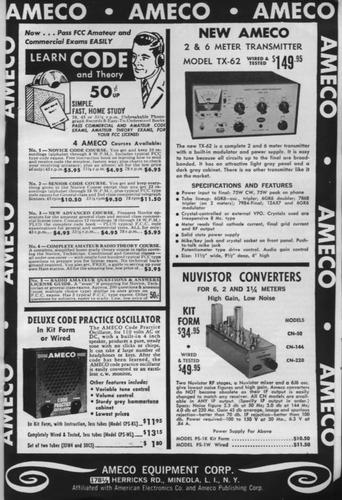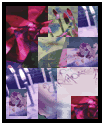(above) Advertisement 1: Heath
Heath made a tremedenous influence on Novice history. They made the popular Heathkit DX 60 transmitter which was probably the most used Novice transmitter. Once built the transmitter would likely be sold by its first owner to other Novices. Once that Novice upgraded, s/he probably sold it to another Novice, and so forth. All advertisements on this page, unless otherwise noted, are from the from 1964 edition of the ARRL's How to Become a Radio Amateur. Used with permission of the American Radio Relay League (ARRL). Thanks to Bill Kotarski, N8JOS for scanning these ads. Editor's Request - Please let us know you have any other Novice artifacts you would like to share in jpeg format.
|
|
(right) Adversiement 2: Ameco
Ameco was major name in the amateur radio licensing business. They sold what ever one needed to study for an exam: books, code practice records (later cassette tapes), and code practice oscillators.
|
 |
(right) Advertisement 3: Burstein & Appleby
This ad shows code practice oscillators and records (LP, vinyl) which were used to learn Morse code.
|
 |
(right) Advertisement 4: Instructorgraph
For the more affulent would-be Novice, the Instructorgraph was the way to learn Morse code. This machine was a mechanical code generators. It use perforated paper rolls which had dots and dashes on them. One would thread the roll, much as one would thread a film projector and then the machine would play the Morse code.
|
 |
(right) Advertisement 5: E.F. Johnson - Viking
E.F. Johnson's Viking transmitters were popular with Novices.
|
 |
(right) Advertisment 6: National
Not every Novice had a Heath DX 60 transmitter. Here is one competing model, the National NC-121, which was pre-built.
|
 |
|
(right) Advertisement 7: PR Crystals
Crystals were very important to Novices until 1972 when Novices were granted the use of VFOs. Even after 1972, many Novices still used crystals for they probably were teenagers on a limited budget and bought used equipment which was likely a crystal controlled transmitter. It is likely that the VFO privelege came in too late in Novice history to have much of an impact. The typical Novice had only a few crystals. He/she probably did not select those frequencies. They came with the transmitter they probably bought used. That transmitter probably changed hand several times. And probably at least one or two of those crystals were bad since they had been overused and misued by several generations of Novices. The strategy of being a Novice was that they wanted to get on the air (GOTA), get their code speed up, (get as many QSLs as they could) and upgrade as quickly as possible for the Novice was a non-renewable license until 1978. Buying crystals was uneconomical.
|
 |
(right) Advertisment 8: Vibroplex
Vibroplex makes keys, specializing in the semi-automatic bug. Most Novices struggled with their sending using a J-38 straight key, hopefully off the air using a code practice oscillator. Some Novices developed their Morse code sending and used bugs, while their fellow Novices struggled to develop a fist decent enough to go on the air with.
|
 |
|
|

|
|
|
|
|
|
|